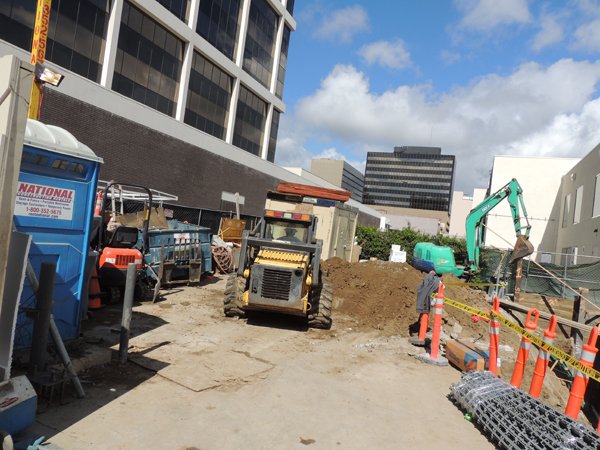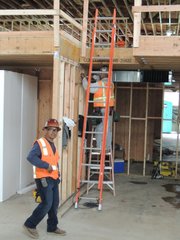BEFORE THE GLITTER: Construction crews work on the space of what will become the Burberry building on the corner of Rodeo Drive and Dayton Way.
Behind The Scenes on Rodeo: Shawmut Renovates High End Street
For Rodeo Drive, renovating boutiques is a multi-million-dollar enterprise.
The highest-marquee retailers of the street, such as Hermès and Prada, wrapped up extensive renovations of their boutiques in 2013, and boutiques for Chanel, Saint Laurent and Louis Vuitton are expected to finish the renovations of their Rodeo stores this year. U.K. retailer Burberry started construction of its own building in February at 301 N. Rodeo Drive. It is scheduled to open in late 2014, according to a Burberry statement.
A select handful of construction companies typically win bids to build Rodeo flagships, which are said to have price tags ranging from $1 million to more than $15 million. The renovation work is exacting, but it is worth the trouble, said William Pisani, vice president of retail at Shawmut Design and Construction, which opened a Los Angeles office in 2013 and worked on 10 projects on Rodeo during the same year. Pisani said much of his company’s current business is in renovation.
“We are seeing more boutique renovation projects than new stores,” Pisani said. “Most retailers are continually renovating their stores every few years to keep their image fresh and keep up with competitors. That’s good business for them—and for us!”
This ongoing boom in renovation is unique in retail, said Kimberly Ritter-Martinez, economist for the Los Angeles County Economic Development Corp. “Nonresidential construction is starting to improve, but the gains are mostly in industrial construction,” she said of warehouse and distribution centers being built by e-commerce and international trade companies. “We haven’t seen much in the way of new office construction, and retail is lagging behind that. High vacancy rates, weak consumer spending and competition from online retailers are weighing on new retail construction.”
On Rodeo, contractors typically must go beyond the city of Beverly Hills’ general codes for construction. “Rodeo Drive is one of the most challenging environments for construction,” Pisani said. “Construction activities need to be as close to invisible as possible.”
It’s hard to be invisible when construction crews are demolishing the interior of an old shop. Crews of 40 to 100 construction workers must look for ways to not disturb the shopping and commerce going on in the street. Their activities are kept out of view by keeping most of their work behind barricades and in alleys.
Items must be handled with care. In recent jobs, Shawmut’s crews installed gold-leaf ceiling work at Tory Burch on Rodeo Drive. For Tom Ford’s Rodeo boutique, they installed high-gloss lacquer, glass and chrome. Since 2012, most stores have been working with more natural materials, such as stones and wood veneers and stainless steels, said Vincent Spataro, a Shawmut project executive who has worked on renovation projects for Louis Vuitton and Jimmy Choo.
A sense of diplomacy is key to the success of high-end retail projects. Construction companies such as Shawmut also must balance the demands of top architects, star designers and retailers who often want to make revisions great and small to store plans as contractors race toward deadlines. “The design teams put so much emphasis on flagships on Rodeo. They are constantly looking to improve the design,” Spataro said. “A lot of times it doesn’t end until the store opens. We get down to the wire on improvements from the designers.”
Toward the end of projects, it is typical for Shawmut crews to work separate eight-hour shifts. For night work, they have to get special permits from the city of Beverly Hills.
There are no seminars or special training on working with new building materials designers want to experiment with. The skill is learned on the job, Spataro said.
“The companies that can marshal the necessary requirements of these projects are noteworthy,” says Giorgio Borruso, founder of Giorgio Borruso Design, a Los Angeles architecture firm that has designed award-winning retail projects internationally, including buildings at The Americana at Brand in Glendale, Calif. “I sleep better if there is a good [general contractor] on board,” he said. “Our projects are often very challenging. They require great flexibility and exacting attention to detail. Coordination with international subcontractors and knowledge of local sites, conditions and codes are essential skills. As in any business, the reputation of a construction management company and its ability to bring all the project’s components together on an aggressive schedule are key in the selection process. We look for companies with a proven track record but not to the exclusion of smaller contractors with promising projects in their portfolios,” Borruso said. He has not worked with Shawmut in the past.
There are fewer than 10 national companies such as Shawmut with the skill sets to run renovations of high-end retail boutiques, according to architects and real estate executives who work on these projects. Many retailers and mall owners maintain lists of pre-approved contractors. However, architects do have freedom to take risks on unproven contractors.
Real estate brokers working on Rodeo Drive estimate that the current wave of boutique renovations is the biggest in more than a decade. Jay Luchs, executive vice president of NewmarkGrubbKnightFrank, said high-end retailers typically renovate their stores every three to seven years, adding that renovations typically hedge on the lease. Luchs believes that the current spike of renovations is a vote of confidence in Rodeo’s luxury market. “When they re-sign a lease on Rodeo Drive, they feel more comfortable in doing a major renovation. If they only have two years left on a lease for example, they won’t spend millions of dollars on the short term.”
Schedules for renovations can range anywhere from a few months to more than 18 months, said Chuck Dembo, a partner in Dembo Realty. Because renovations take so much time, retailers often set up shop in temporary spaces. But it’s getting tougher to find temporary space on the crowded street. “Space is tight now,” he said. He contends that temporary shops, construction and colorful barricades add to the entertainment for the street’s tourists and frequent shoppers. “It creates excitement,” he said.
























